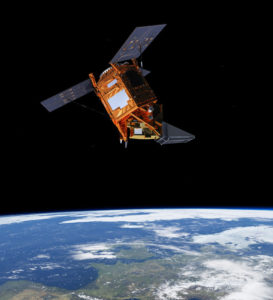
The Airbus-built pollution monitoring satellite Sentinel-5 Precursor has been successfully launched on a Rockot from the Plesetsk Cosmodrome in Russia at 09.27 GMT on Friday, October 13, 2017.
Sentinel-5 Precursor is part of the Copernicus global monitoring programme, a joint European Commission–European Space Agency undertaking which aims to acquire continuous and accurate Earth observation data and provide services to improve the management of the environment, understand and mitigate the effects of climate change and ensure civil security.
Sentinel-5 Precursor will provide essential atmospheric chemistry data to the Copernicus programme before the Sentinel-5 instrument becomes operational in 2021 on the MetOp Second Generation satellite.
Airbus was prime for Sentinel-5 Precursor, with four sites involved in development and manufacturing of the satellite and its components: Stevenage (UK – prime contractor), Toulouse (France), Friedrichshafen (Germany) and Leiden (Netherlands).
Colin Paynter, Managing Director of Airbus Defence and Space in the UK, said, “Today’s successful launch again moves forward the European Sentinel programme in which Airbus is playing a key part. Sentinel-5 Precursor was built in record time using the commercially successful AstroBus platform, and demonstrates Airbus’ ability to adapt its range of hardware to new missions to meet important operational needs.”
The UK’s Universities and Science Minister, Jo Johnson MP, said, “The successful launch of the Sentinel-5 Precursor satellite is a clear demonstration of the UK’s valuable contribution to improving global knowledge through satellite data, and the heights we can reach by collaborating with our European partners. Our ongoing investment in the UK space sector forms a key part of our Industrial Strategy, and we are committed to ensuring that we have the infrastructure and skills in place to support our ambition to capture 10% of the global space market by 2030.”
“With Sentinel-5 Precursor in orbit, we have achieved another important milestone that takes the European Commission-led Copernicus programme into a new area: observing the air that we breathe,” said Josef Aschbacher, Director of ESA’s Earth Observation Programmes. “Without the substantial contribution of the Netherlands to the TROPOMI instrument on board this satellite, we would not have been able to build this satellite. And it was a European collaboration of 30 high-tech companies under the leadership of Airbus Defence and Space which made the mission possible.”
Sentinel-5 Precursor features the TROPOMI (TROPOspheric Monitoring Instrument) instrument, developed by Airbus DS Netherlands for the European Space Agency (ESA) and the Netherlands Space Office. TROPOMI will measure ozone, nitrogen dioxide, sulphur dioxide, methane and other atmospheric pollutants at a higher resolution than previous instruments. Having more accurate atmospheric data will enable improved climate models and pollutant tracking and forecasting. The MetOp Second Generation spacecraft will feature a different Sentinel 5 instrument.
Successful separation of Sentinel-5 Precursor from the launcher was achieved at 10:46 GMT, on October 13, 2017.
 SpaceWatch.Global An independent perspective on space
SpaceWatch.Global An independent perspective on space

